Hi dear all, here is “My Working Notes Part 7”. The link is
https://drive.google.com/drive/folders/1e7zYivz-Tvw7ImQOYP8ArXXCmXsPvTbn?usp=sharing
Happy Knotting
yChan
Hi dear all, here is “My Working Notes Part 7”. The link is
https://drive.google.com/drive/folders/1e7zYivz-Tvw7ImQOYP8ArXXCmXsPvTbn?usp=sharing
Happy Knotting
yChan
yChan,
Thanks for your good work…am having a look over this weekend (and no doubt so will Xarax!).
In reply to an older post of yours from last year…just some photos to illustrate why I favor showing the ‘chirality’ (handedness) of loops.
By reversing the ‘chirality’ of the loops (and reversing the crossing points) - you can make lots of interesting discoveries.
With #1425A Riggers bend, using interlinked L/hand loops (instead of R/hand loops) creates an interesting result (depending on the overlaps of crossing points).
I dont have a photo of inter-linked L/hand loops for #1425A…but will try to capture a photo soon and upload (to show side-by-side comparison with R/hand loops).
I think you are on a parallel path to me…
Xarax has done a lot of work on this topic - and it was he who first brought the importance of chirality to my attention during early development of my Bowlines paper (which I am presently reviewing and amending).
Mark G
EDIT NOTE:
Okay - I have had a look through almost all of your work - and you have put a lot of effort into it. We need more people like you doing this kind of research.
I would like to be critical if I may (sorry - peer review is what advances the science of knotting…).
A lot of your bends all come down (in the end) to loop chirality and crossing points.
If you follow your tying diagrams to their final step - the loops are either inter-linked or superposed - and the chirality is either the same or opposite.
Now - I do have an issue with what you refer to as a ‘false Hunter/Riggers bend’.
Structurally, it ought to be referred to as a ‘false Zeppelin bend’.
This is because the loops of a Zeppelin bend are superposed (and not inter-linked).
I can see why you like to call it a ‘false Riggers bend’ - because the shape does have some similarity to the true #1425A Riggers bend.
But, the fact is that the loops are superposed. Whats wrong is the ‘chirality’ of the loops. In a true Zeppelin bend, the loops must be of opposite chirality and the tails must point in opposite directions.
In your tying diagrams of what you call a ‘false Hunters bend’ - if you look closely - you will see (on the final step image) that the loops have the same chirality.
I am sure Xarax will weigh in here…
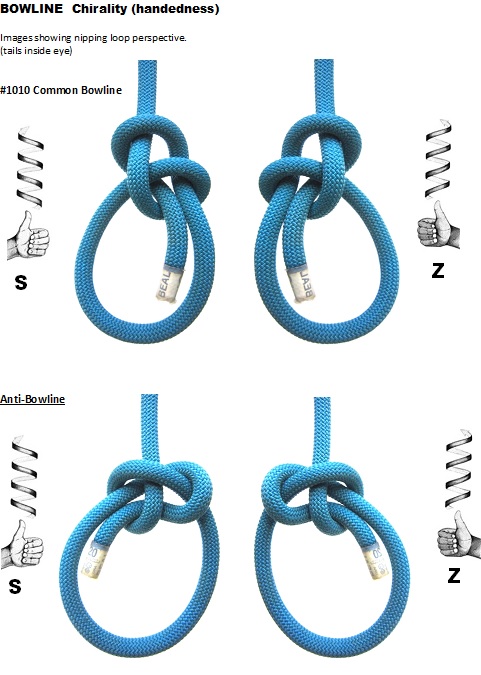
Hi Mark,
Thanks for the comments.
The FHB and ZB are both superposed loops. In my “Loops Formations Chart of Bends”, they are in Types 1 and 2, but in different sets. FHB is in the set with SHB, 1453, HB and 1426. ZB is in the set with YLB, this indicates that superposed and inter-linked are taken places in Type 1, 2, 3 and 4. Within the same set, Type 1 to 4 have the same chiralities but loops are in either superposed or inter-linked (in two ways). Since FHB is in the same set with HB, that is the first point I named it FHB.
The second point is : the tying method (different starts) shown both in HB and FHB are similar with little difference. But you cannot do it with ZB. (see other tying methods of FHB and HB).
The third point is : the finished FHB and HB look nearly the same except on one side (because the loops superposed or inter-linked)
The forth point is : the collars of SParts of FHB and HB are the same on one side. But the collars of SParts of ZB are opposite/upside down. This is the main and most easy distinguish point to identify them.
The fifth point is : both HB, FHB and SHB have their own 8 loops formations (chiralities varied), but ZB has 6 loops formations only.
Upon these points, I named it False Hunter’s Bend.
yChan
Hi siriuso and agent_smith,
even if I agree with agent_smith, I think we won’t change our own minds so we should stop naming a knot/bend a “false something”. I think we should follow D. Mandeville (who, as far as I know, first showed the bend in his Alphabend (see KM4 or KM18)) and name it Bend N or “Neat & New”.
However, to my mind a knot is a knot, it’s not its tying method(s)!
Ciao,
s.
Hi vChan,
Thank you for your reply.
I will do as knotsaver suggested - I don’t think I can change my mind!
Here is my analysis of your so-called ‘False Hunters Bend’ - with opposite twist tying method:
In your ‘False Hunters bend’ that allegedly begins with interlinked-loops, what in fact is happening is that your opposite twist tying method is creating a ‘false positive’!
Your so-called ‘opposite twist’ tying method is forcing a square peg in a round hole so-to-speak…and it induces an instability. The moment you attempt to set and dress the knot (it capsizes) - and undergoes a ‘energy phase-change’.
Once it has ‘capsized’ (or ‘energy phase change’ for want of a better term) - it self-orients to its ‘intermediate stable form’.
From this ‘intermediate stable form’ - as increasing load is applied - it undergoes a further energy phase change.
The collars actually morph - and switch. The final stable energy state that is achieved has the same ‘appearance’ as #1425A Riggers bend - but is axially-rotated so that the SParts and tails are exchanged.
Now, if you reverse engineer the knot, carefully removing the tails from the central toggle-axis, you will see that it is nothing more than 2 superposed loops of the same chirality!
So I see your ‘opposite-twist’ tying method as an illusion - because in the end, it is in an unstable energy state - so the structure undergoes a phase-change to try to find its most stable form. And when you reverse engineer the final knot, it is nothing more than 2 superposed loops of the same chirality.
Mark G
Edit: Grammar edits…
even if I agree with agent_smith, I think we won't change our own minds so we should stop naming a knot/bend a "false something". I think we should follow D. Mandeville (who, as far as I know, first showed the bend in his Alphabend (see KM4 or KM18)) and name it Bend N or "Neat & New"
Indeed.
One can try to dig through historical work to find support for an argument - we do that all the time.
But, the term ‘false’ does have a place in the world of knotting.
The term ‘false’ has been used by other knot book authors on occasion - notably by Ashley and Budworth - no doubt to emphasize a point (ie a knot looks the same, but really isn’t).
What I see as important with bends built from superposed or inter-linked loops is chirality and orientation.
What yChan refers to as a ‘false Hunters bend’ - to me, has structural beginnings from 2 superposed loops (despite his ‘opposite-twist’ tying method which is nothing more than a trick method).
Mark G
Request to moderators…
I think that this thread should be moved to ‘Knotting concepts and explorations’.
The subject matter is exploring concepts that are interesting - and will generate further interest.
There is a lot more to be discovered by experimenting with superposed and inter-linked loops - and to determine the underlying science/reasoning of how ‘bends’ (end-to-end joining knots) are formed.
Mark G
Hi dear all, thanks S. and Mark, I agree to move this thread for further discussion under some other topic.
yChan
I have attached an image showing inter-linked loops which form the starting base for tying #1425A Riggers bend.
In the attached JPG image:
the top schematic shows L/handed chirality.
the bottom schematic shows R/handed chirality.
‘X’ indicates the central axis - through which the tails must penetrate in opposite directions.
Note the crossing points have reversed (indicated with ‘O’)
Tie each knot to its conclusion…and each is the mirror of the other.
Alter any of these parameters - and you end up with something other than #1425A Riggers bend.
NOTE: I should also point out that the tying method depicted in Ashleys Book of Knots at illustration #1425A induces an instability similar to that which occurs with yChan’s ‘opposite twist’ method (for his so-called 'False Hunters bend). The tying method illustrated capsizes into a energy stable form immediately when load is applied.
As with yChan’s method - it appears at first instance that you begin with superposed loops of the same chirality. But this is a trick method - because the structure immediately capsizes into an energy stable form the moment load is applied, while trying to set & dress it.
If you reverse engineer the stablised knot - by carefully removing the tails from the central axis, you are left with none other than 2 inter-linked loops of the same chirality!
Mark G
PS… Thanks for moving this thread Scott ![]()
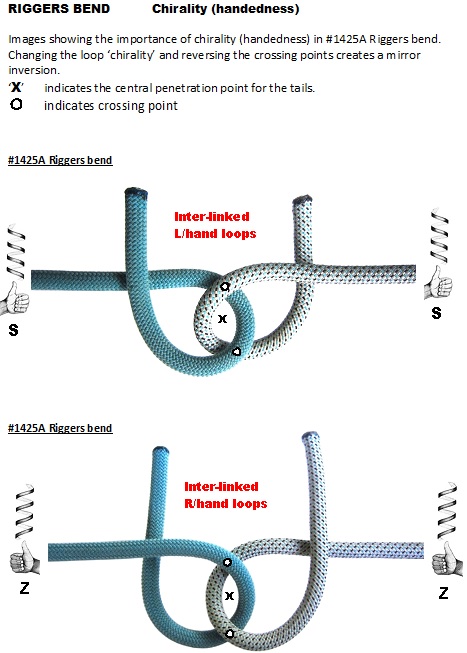
…
ok, I tried to shelve the discussion with historical argument (by the way, I forgot to mention Miles B6 Pivotal knot (after Mandeville))
…
Let’s try to change yChan’s mind ![]()
![]()
…
YChan gives a lot of importance to the tying methods, but these are useful but can say nothing about the knot, we can obtain completely different knots with a different tuck/crossing (please, see Mandeville’s Trambles (KM10,18,19,…) or Miles’ symmetric end twisting (Symmetric Bends Ch8 “How to invent Symmetric Bends”) p.154)).
I said a knot is a knot, it’s not its tying method(s) because it is not important how we obtain the knot but how it is, how it works: it is important its structure, its topology and above all its geometry! So IMO it is more important to compare structures, geometries than tying methods! The analysis of the structure can tell us something about how the knot will work, if it will jam…the tying method not!
With this perspective the Zeppelin and the “Neat&New” are, as Xarax likes to say, rope made hinges, but the Neat&New (it’s too long Neat&New I will say Bend N) distorts the pin.
2 days ago I tied a Double Zeppelin and a Double false Zeppelin eehh ![]() a Double N (maybe useful for dyneema) they look very similar and with the “doubleness” they work in a similar way.
a Double N (maybe useful for dyneema) they look very similar and with the “doubleness” they work in a similar way.
Hope this helps (to change yChan’s mind ![]() )
)
Ciao,
s.
Image showing the relationship between loop chirality and mirror image outcome.
We can say there are 2 forms of #1425A Riggers bend:
S form
Z form
Note this same principle would apply to other symmetric bends (eg Zeppelin bend).
Mark G
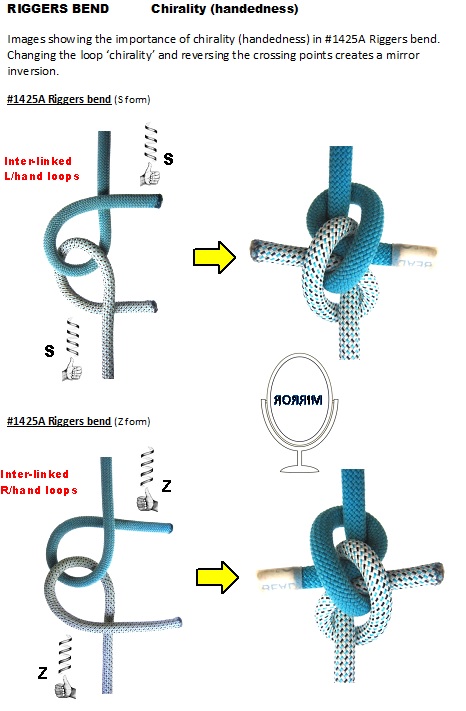
Hi dear all, thanks to s. and Mark, your informations are valuable to me. I read the relevant KMs, and know that this bend was mentioned. By then it was named False Zeppelin Bend and in my “My Working Notes” I name it False Hunter’s Bend, and am questioned for reasons.
Unsally we name a knot by the name False because we mean that it resambles the Real one, and alert tiers that though both knots are seemed alike but the false one is not save or securer for use. We are also sure the structure are a bit different too.
The following characteristics may help to understand why I named it FHB :-
HB : Chirality - ZZ and SS. Inter-linked.
FHB : Chirality - ZZ and SS. Superposed.
#1425 : Chirality - ZZ and SS. Superposed.
ZB : Chirality - ZS and SZ. Superposed.
HB : Common known tying method - Opposite
FHB : My tying method - Opposite (Hi Mark, please neglect Opposite Twist. You says it is tricky. I say it is a tucking becomes a transformation.)
#1425 : My tying method - Opposite.
ZB : My tying method - Parallel (Spiral Drops, Parallel Riding).
HB : Appearance (tightened) resembles FHB (un-tightened).
FHB : Appearance (un-tightened) resembles HB (tightened). Appearance (tightened) resembles ABOK#1425 (tightened).
#1425 : Appearance (tightened) resembles FHB (tightened).
ZB : Appearance not resembles HB. Appearance not resembles the so-called False Zeppelin Bend(un-tightened).
I have made a pdf. here on the comparison of these 4 bends. The link is :-
https://drive.google.com/drive/folders/1DeTLj-s7VxgGjQL8bQTMZ9C8EoVV1mB3?usp=sharing
I would like to ask as I have based on all the charteristics found for matching for False Hunter’s Bend, still I have been requesed or to be convinced to use ‘False Zeppeline Bend’ which is of superposed likes Zeppelin Bend but with different chirality from Zeppelin Bend.
Finally may I suggest this questioned bend remains it?s first name - Neat & New Bend, or a False ABOK#1425 (see the characteristics tabulated).
Happy knotting
yChan
I would like to ask as I have based on all the charteristics found for matching for False Hunter's Bend, still I have been requesed or to be convinced to use 'False Zeppeline Bend' which is of superposed likes Zeppelin Bend but with different chirality from Zeppelin Bend.
Its good to see that you are beginning to shift toward toward the underlying structure of these end-to-end joining knots.
In your latest pdf file - on the right hand side - you are showing the loops and their chirality - whether superposed or interlinked.
On the left-hand side - you are showing tying methods. Its the right hand side with the loop chirality that is the fundamental science behind these knots.
The key to your question is the schematic diagrams at the right hand side of your pdf document.
It all comes down to these diagrams.
A Zeppelin is built from superposed loops - not from inter-linked loops.
#1425A Riggers bend is built from inter-linked loops - not from superposed loops.
What you refer to as a ‘false hunters bend’ - is actually built from superposed loops. From a structural viewpoint, it is therefor more closely aligned to a Zeppelin bend. The use of the term ‘false’ will always attract controversy. To some, it imputes a useful meaning. To others, the term is irritating.
Now - I have some comments as follows:
“Tying method #3” - (at top). The tying method is inducing an instability which forces the structure to re-orient to try to find a energy stable state. Its a ‘trick’ tying method.
“Tying method #6” - The loops are superposed which is a key structural beginning. At low loading/energy state - the structure is based on the Zeppelin bend. With increased loading/energy, the structure undergoes further change and morphs so that it is axially rotated 90 degrees. You refer to this structure as ‘False Hunters Bend’ - which I disagree with. I have personally witnessed a climbing Guide tie what he thought was a Zeppelin bend (to join his abseil ropes together so they can be ‘retrievable’). I watched him join the ropes together, end-to-end. What he in fact tied is what you refer to as the ‘False Hunters bend’. He was convinced that it was the Zeppelin bend - and was about to proceed with his abseil descent down a very big vertical cliff. I stopped him just in time - and pointed out the error. He examined the knot and disputed that it was incorrectly tied. I pointed out the error in close detail - and tied a correct Zeppelin and held it side-by-side with his knot so he could observe the difference. His eyes went like fried eggs and his face went pale. I told him that he had in fact been fooled into thinking it was a Zeppelin - and he then stated; “Ahhh - I’ve tied a false Zeppelin bend!” (I did not prompt him with the word ‘false’ - he thought of this term himself).
Note: To my knowledge (as far as I am aware) - the ‘false Zeppelin’ has not been tested for human life support applications in rock climbing and abseiling. So to experiment with your life on an untried joining knot is unwise. That’s why I stopped him and pointed out his error.
“Tying method #8” - same tick method - it forces the knot to undergo an energy state change as soon as load is applied (sort of like the capsizing event in the carrick bend).
The last 2 lines (#1425A Riggers bend and Zeppelin bend) - excellent - you show the loops and their chirality (S versus Z).
However, on the left, you show your various tying methods - which to me is irrelevant (sorry). The tying method is not telling us anything about the fundamental structure.
For me personally, you could wholly delete all the tying methods and just focus on the schematic diagrams on the right (showing loops and their chirality).
Finally may I suggest this questioned bend remains it?s first name - Neat & New Bend, or a False ABOK#1425 (see the charteristics tabulated).You can indeed suggest this but, my view is that the term 'false Zeppelin' has a place. You'll find other terms such as 'evil imposter' / 'evil twin' and so forth... The term 'false' has been used by other knot book authors (eg Ashley and Budworth) - and I can understand their choices.
knotsaver (IGKT member) has alluded to historic publications where non-descript names were given or an arbitrary number were assigned. I am not in favor of this approach because it has no underlying meaning.
Hi, I’m a canyoneering enthusiast from Utah (USA), primarily interested in practical applications. The other day, a knot picture appeared on a canyoneering forum and no-one could identify/name it (see image link below). The OP stated that it was a Rigger’s Bend but in fact it was not. Turns out it’s the knot of the moment right here, the Maybe-False-Something Bend. ![]()
From a practical perspective, and especially regarding knot inspectability in recreational canyoneering, False Zeppelin is not a useful name. It would perhaps be useful if this knot could easily be mistaken for a Zeppelin, but the opposite is true: it is easy to tell at a glance that the knot is no Zeppelin. However when well-tightened, it is not readily distinguished from a well-tightened Hunter’s Bend. So if one were inclined to use “False” in the name, False Hunter’s makes more sense than False Zeppelin.
Obviously there are multiple ways to approach knot-naming - has there been any concerted effort to create a knot naming standard? Haha.
bq
https://drive.google.com/drive/folders/1M4M8jhg-dbOX1IqvXBBZdQve5doc05LW?usp=sharing
Hello and welcome bipoqid!
From a practical perspective, and especially regarding knot inspectability in recreational canyoneering, False Zeppelin is not a useful name.I disagree. Also, in terms of underlying structure, #1425A Riggers bend and the Zeppelin bend are completely different. One is built from inter-locking loops of the same chirality while the other is the complete opposite.
It would perhaps be useful if this knot could easily be mistaken for a Zeppelin, but the opposite is trueThat is a matter of perspective. If you look more closely, rather than a superficial glance - the differences become more obvious.
However when well-tightened, it is not readily distinguished from a well-tightened Hunter's BendThat's not right...if you set and dress the 'false Zeppelin' bend [u]tightly [/u]- it [i]morphs [/i]and axially rotates 90 degrees. Try the same process with a correctly tied #1425A Riggers bend - and it does not morph or axially rotate. [b]Have you tried this yourself?[/b] Also, the Riggers bend has a very [i]distinctive [/i]shape - beautifully interlocking rope segments.
So if one were inclined to use "False" in the name, False Hunter's makes more sense than False Zeppelin.I disagree (again) - I have seen the opposite occur - with a Guide tying what he thought was a Zeppelin bend but, which in fact was the 'false' Zeppelin bend.
Obviously there are multiple ways to approach knot-naming - has there been any concerted effort to create a knot naming standard?Where possible, to be clear and accurate, knotting enthusiasts try to use 'ABoK' numbers. The ABoK number refers to an illustration in the 'Ashely Book of Knots' which is widely regarded as a definitive work on knots and knotting. When there is no ABoK number for a particular knot, we then look for historical info and/or consensus opinion.
…
Have a close look at my attached photo…look very closely - you will see distinct physical differences which characterize each knot.
Mark G
Hi, can anyone tell me when the False Zeppelin Bend was named and by whom ? Thanks.
yChan
Hi, can anyone tell me when the False Zeppelin Bend was named and by whom ?Why is this important to you?
On what path do you wish to proceed?
yChan - I think perhaps the issue is the fundamental structure of the Zeppelin bend versus #1425A Riggers bend.
Here are some questions for you:
Do you agree that the Zeppelin bend is built from 2 superposed loops of opposite chirality? Yes No
Do you agree that #1425A Riggers bend is built from 2 inter-linked loops of the same chirality? Yes No
Your answers to these fundamental questions will shed some light on where we go from here…
Thanks again to Mark for your response.
Your questions have already been printed on my previous thread together with the pdf. Up to now you have not made comments on the bends outlooks. Are they not relevant for discussion?
My wife is a knitting lover. She knitted numerous knitting wears in different patterns for me. Last night I asked her how would you select patterns for knitting? She said that she would choose for the good looking pattern and by it’s complexity in knitting. That means she firstly judged by the outlook and then the knitting technique required for her to accomplish the pattern. Having read the incident that you mentioned above about a climber who mis-tied a bend. I would like to know how did you acknowledge immediately he tied a wrong bend or a Hunter’s Bend that was not as good as Zeppelin Bend? Yes, let me guess the answer for you. You instantly recognised it was a Hunter’s Bend (by it’s outlook/appearance) or a bend like Hunter’s Bend. You un-tied it and found it was not a Hunter’s Bend, but a False Zeppelin Bend. This leads me to believe that you can easily distinguish them by their characteristics of collars as every tier does. Thanks to this, you acted what you ought to do to deliver your expertise to save this climber.
A more common practice, one wants to buy a BMW car. He looks for a BMW car (by outlook). He would not check every part of the car, until someday it breaks down for repare or overhaul and find that some part is not genuine. That is what we compare things firstly from the outlook and for more, it is the content/components/structure etc.
Nothing is important to me.
Happy Knotting
yChan
In the attached images, 3 knots are presented: A, B, C.
From a practical in-the-field I.D. perspective, please consider the following questions for each knot pair:
bq
p.s. there is a certain level of absurdity in my attempt to present a practical perspective on this naming issue, due to the fact that none of the bends under discussion see common use in recreational canyoneering. That said, some groups are leaving slings behind in canyons, tied with the False Hunter’s Bend, thinking they are tying the Hunter’s. This pic from my last post shows such a sling, which was cleaned from its anchor by an safety/enviro-conscious canyoneer. The person who tied this knot is apparently unable to differentiate between it and the real thing.
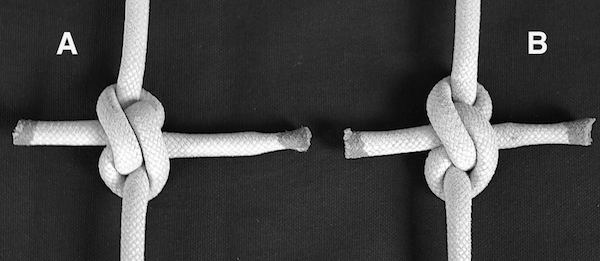
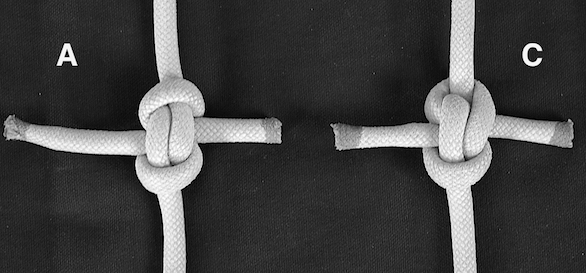
Hello yChan,
I would like to know how did you acknowledge immediately he tied a wrong bend or a Hunter's Bend that was not as good as Zeppelin Bend? Yes, let me guess the answer for you. You instantly recognised it was a Hunter's Bend (by it's outlook/appearance) or a bend like Hunter's Bend.No - 100% incorrect.
Be advised that #1425A Riggers bend in fact is very secure. You can in fact use this knot to unite 2 climbing ropes.
However, it is not jam resistant - meaning, there is a risk that you may struggle to untie your ropes.
So if i had recognised the mistake as a ‘Riggers bend’ - I would not have been concerned.
Please look at my attached images. Note the properly tensioned dressing state of the false Zeppelin bend - now it looks quite different?
You un-tied it and found it was not a Hunter's Bend, but a False Zeppelin Bend. This leads me to believe that you can easily distinguish them by their charteristics of collars as every tier does. Thanks to this, you acted what you ought to do to deliver your expertise to save this climber.100% incorrect again. I recognised it immediately as a false Zeppelin bend. I didn't need to untie it to reach that conclusion.
…
yChan - where are you going with all this?
What are you ultimately hoping to achieve?
What do you hope to prove and to whom?
I am looking at bends from a structural perspective - and not a superficial appearance that is only skin deep. I seek to understand the underlying structure in knots.
…
I like you work - you have put a lot of effort in - and you should be congratulated as such. You have photographed an array of different ways to arrive at the same knot. At the end of the day - it is still the same knot - a knot isn’t defined by its tying method (and this is key to move forward).
My interest is not in your ‘tying methods’ per se - rather, its the fundamental structure upon which symmetric bends are built.